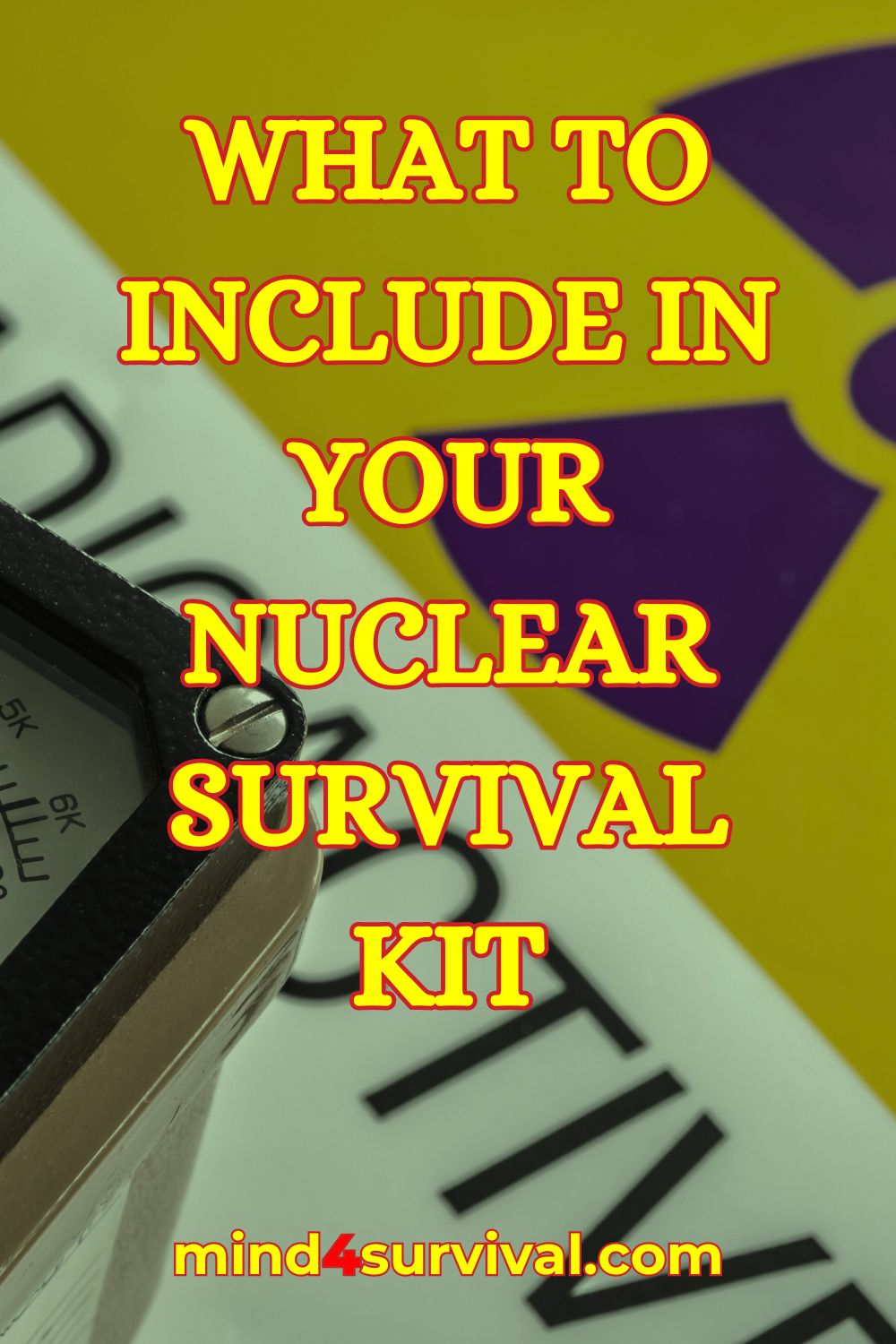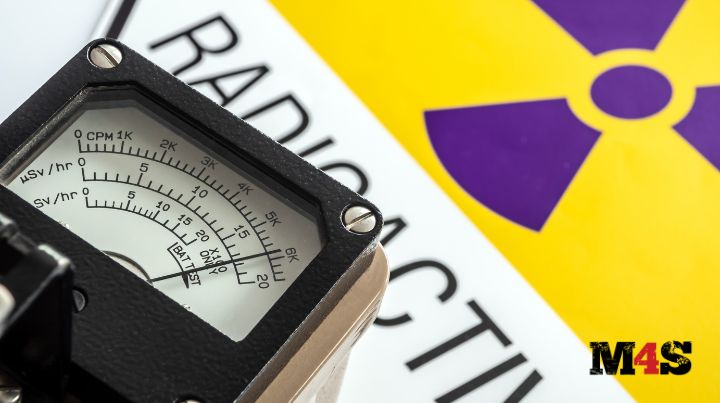With various crises unfolding around the world, it’s hard not to contemplate nuclear war. If you are truly concerned, maybe it’s time to think about what to keep in a nuclear survival kit.
Anyone not killed in the initial atomic blast will not want to go anywhere. Radioactive particles (radionuclides) will be everywhere, so the longer you can stay indoors, ideally in an underground location like a basement, the better.
Once your shelter is identified, it’s time to start stocking it. I’ll post a list of what’s considered most useful and then offer some additional considerations.
Essentials:
- Food
- Water (for drinking and cleaning)
- Water purification system (ex: Berkey)
- Soap
- Kitty litter toilet
- Bind-It Wipes
- Clothes
- Contractor-grade trash bag for contaminated clothing
- Gloves
- Potassium Iodide (KI) pills
- Any regular medications taken by family members
- First Aid kit (for inspiration, read here)
- Feminine hygiene items
- Diapers (as needed)
- Flashlight with batteries
- Radio with batteries
- Books, cards, games
- Comfort items for small children
Optional items:
Food
FEMA recommends staying put for at least 24 hours after a blast. However, because it takes time for the radionuclides released during the blast to decay, the longer you can stay put, the better. If you are serious about planning for a nuclear event, storing two weeks’ worth of food and water is a better goal than 24 hours. After two weeks, residual radioactivity will have decreased to less than one percent of the amount present immediately after the blast.
You won’t want to eat anything that has been outside and exposed to fallout after a blast. If you have a lovely vegetable garden, well, it’ll be a loss. Hopefully, you’ve got some canned or dried produce in your shelter with you, along with ample water supplies. How much food you need will depend on the number of people in your household, along with their ages and activity levels. Pregnant women and athletic teenagers will need a lot of food put by; a couple of retirees, not so much. Think hard about how much food your household eats over the course of two weeks and try to have that, in canned or dried form, in your shelter.
Now, what happens when you come out? Can you refill your water bottles?
Water
Well, bear in mind that any nuclear survival scenario will involve massive, long-term grid disruptions. Unless you’re in some remote cabin in the wilderness, with a plan in place to pull water from underground, you should assume any water you find is contaminated.
Water itself will not become radioactive. Anything that has been stored in a closed container will be fine. However, the water you find outside will likely contain radionuclides. If you can remove those contaminants, you will find yourself with drinkable water.
The ideal way to treat contaminated water would be some combination of activated carbon, reverse osmosis, and ion exchange. Berkey water filtration systems will filter out a lot of radioactive substances. Berkey filters use ion exchange technology, along with other filtration materials, to remove most contaminants.
LifeStraws and Brita filters, while popular and great at what they’re designed to do, are not designed to remove radionuclides.
Decontamination Equipment
This site has run other articles about staying clean in SHTF situations, and all that information applies here. Good old soap and water will remove many contaminated substances from your body. However, there are extra products out there that may come in handy.
RadiacWash was a cleaner with a particular blend of substances designed to attract radionuclides. It had been used since the 1950s to clean the full spectrum of radioactive isotopes and had been available in many popular nuclear survival kits. However, the manufacturer has since discontinued the product, so it’s pretty hard to find. There is a product on the market now called Bind It, which is used in many laboratories that handle radioactive material.
Again, soap and water will meet most of your needs. But there is definitely a time and a place for wipes, and if you are willing to spend extra money on a product that will be more convenient than a shower and more effective than a wet paper towel, consider purchasing some Bind-It wipes.
You will also want an extra set of clothes for each person in your household. Suppose it takes you a couple of minutes to get to your shelter location. In that case, you may have picked up radioactive contaminants, in which case you would need to remove your clothes and place them in a thick trash bag, like a contractor-grade bag, that you then keep closed and as far away from you as possible.
Medical Equipment
Potassium Iodide (KI) pills are recommended to prevent the uptake of radioactive iodide. Brian has a thorough article on how it works here, along with a table of recommended dosages.
KI pills don’t protect against any other kind of radioactive materials, so it’s still important to seek shelter and remove any potentially contaminated clothing.
Having First Aid supplies will also be helpful, and the more comprehensive you can make your First Aid kit, the better. Consider taking a First Aid class if no one in your house is certified. Don’t just buy the kits; make sure you have at least one manual about First Aid to help you use your supplies.
Staying Sane
A First Aid manual will be informative, and if you’re stuck in a shelter for a while, will provide some entertainment. Have some books and card games to keep yourself occupied.
A radio is strongly recommended. Cell phone towers will probably be down and often don’t work well after disasters. I was in a hurricane once; for a few days afterward, text messages to my mom would only go through if I was standing on top of the kids’ clubhouse in the backyard. You won’t want to be climbing around to get a signal after a blast; just get a radio.
Staying Comfortable
You need to assume grids will be down. Using something like a propane heater will not be safe if you are trying to stay inside with minimal ventilation. How will you stay warm, especially at this time of year? Keep blankets and sleeping bags in your shelter. Everyone’s needs will be slightly different depending on local weather, the size of their shelter, and how many people they plan on sharing it with.
Optional Nuclear Survival Kit Items
Some nuclear survival kits recommend hazmat suits and gas masks. Let’s talk about that a little.
Honestly, HazMat suits are so cheap on Amazon that it might not hurt to grab a couple. But a high-quality CBRN (chemical/biological/radiological/nuclear) mask is a significant investment, especially if you’ve got multiple people to plan for. What, exactly, would you need it for?
After a nuclear strike, you would have ten to thirty minutes before fallout started coming down. At that point, you really need to be inside, preferably underground, preferably in something with concrete walls.
So, let’s say you have some kind of job where you work outside. You’ve got a great shelter at your house, but you work an hour away. You can drive home, but what about that walk from your car to your basement? If you know that you are likely to be caught outdoors, far from shelter, a high-quality mask might be a worthwhile investment. Just keep it with you; it’s not going to do you any good sitting on a shelf if you need it when you’re an hour away.
If you and your family stick pretty close to home and don’t think the chance of getting caught outdoors a long way from home is very high, I would probably not drop the $1000+ it would take to equip a household of four with CBRN masks. But that risk assessment is different for every home.
Geiger Counters
Likewise, Geiger counters are a higher cost item but may really come in handy. A Geiger counter is used to detect the presence of alpha, beta, gamma, and X-rays. This will come in handy if you have to leave your shelter sooner than anticipated. There are many Geiger counters on Amazon with good reviews. What you choose will depend on your budget and how likely you think you are to get stuck in a less-than-ideal location.
However, before picking a Geiger counter, read reviews carefully. I would caution against the absolutely cheapest ones; most of the positive reviews don’t seem to be written by people who work with radiation.
If cost is a real issue, but you are reasonably handy, you can build a homemade Geiger counter. This might be a better option anyway because you will have a better understanding of how it works. If this sounds like a good project, check out this YouTube video on making your own Geiger counter.
Final Thoughts
It’s good to have a plan in place for any kind of disaster, and most of the items listed above will fill those needs. Maybe a nuclear strike never comes. I sure hope it doesn’t. But a hurricane might. A winter storm that knocks out power and makes travel impossible for a few days might. Having a plan to shelter in place for a few days in a grid-down situation is a good idea for any household, and most of the items listed above will be useful in a variety of disaster situations.
Most of us can’t control who pushes what buttons. We can only control our own mindsets. Hopefully, having a plan in place gives you a sense of encouragement that you can handle whatever comes next.

Read the full article here



